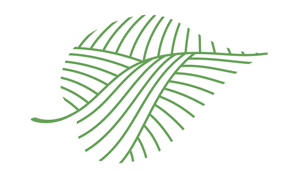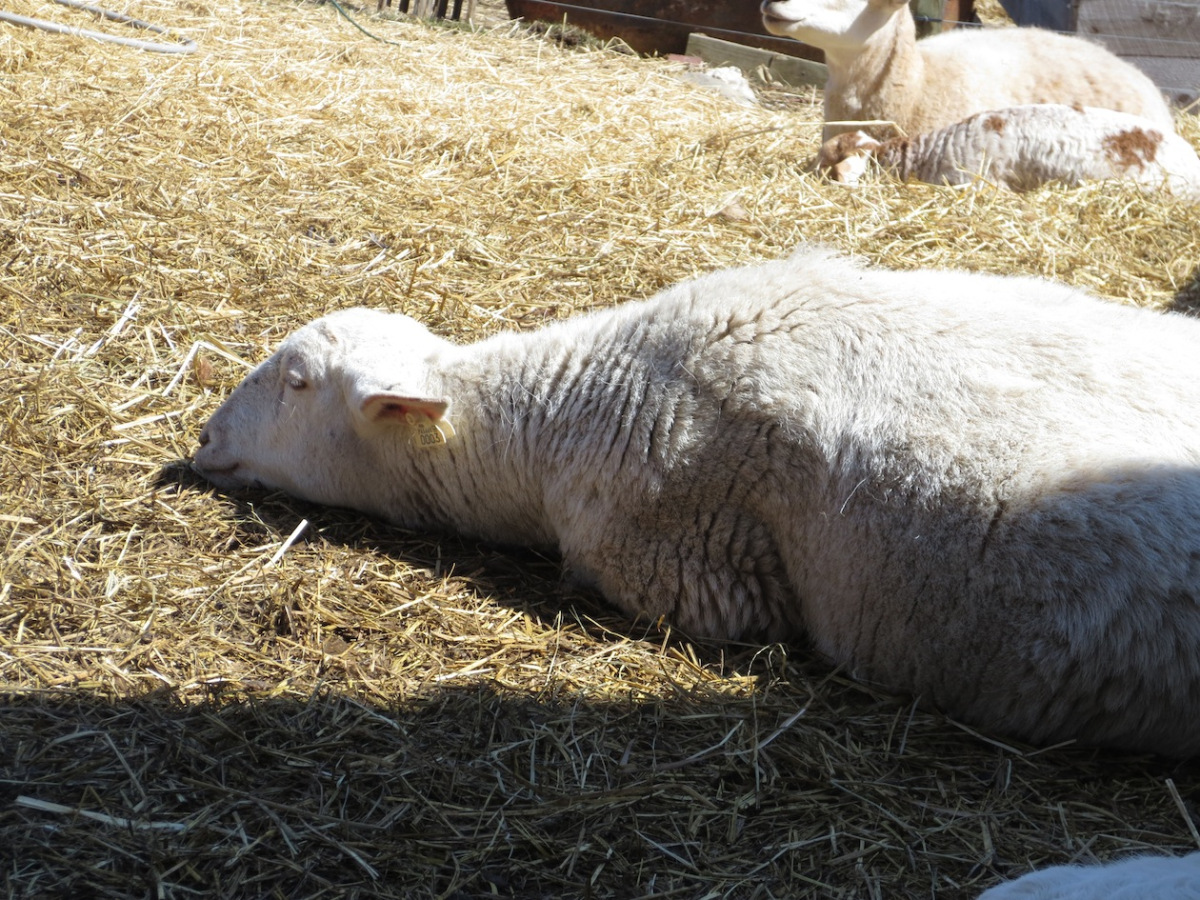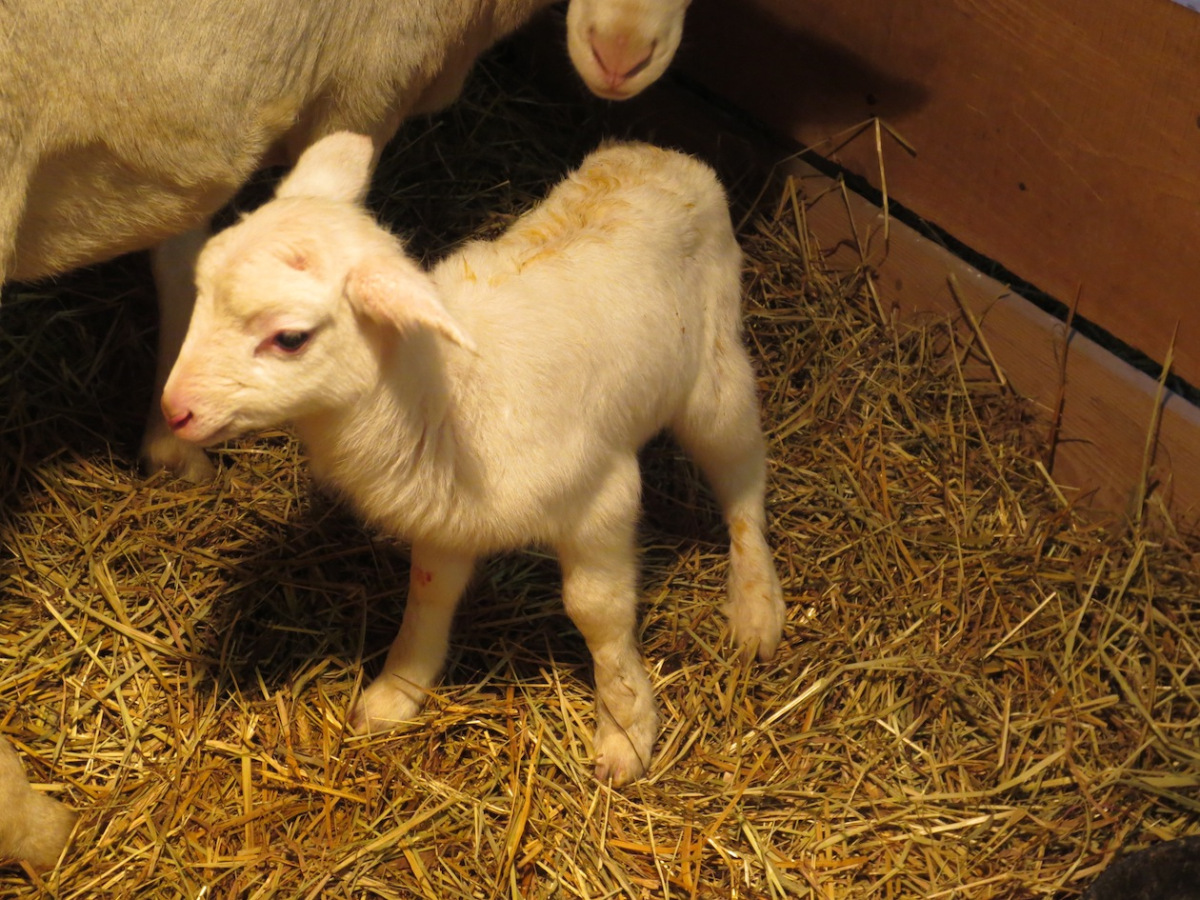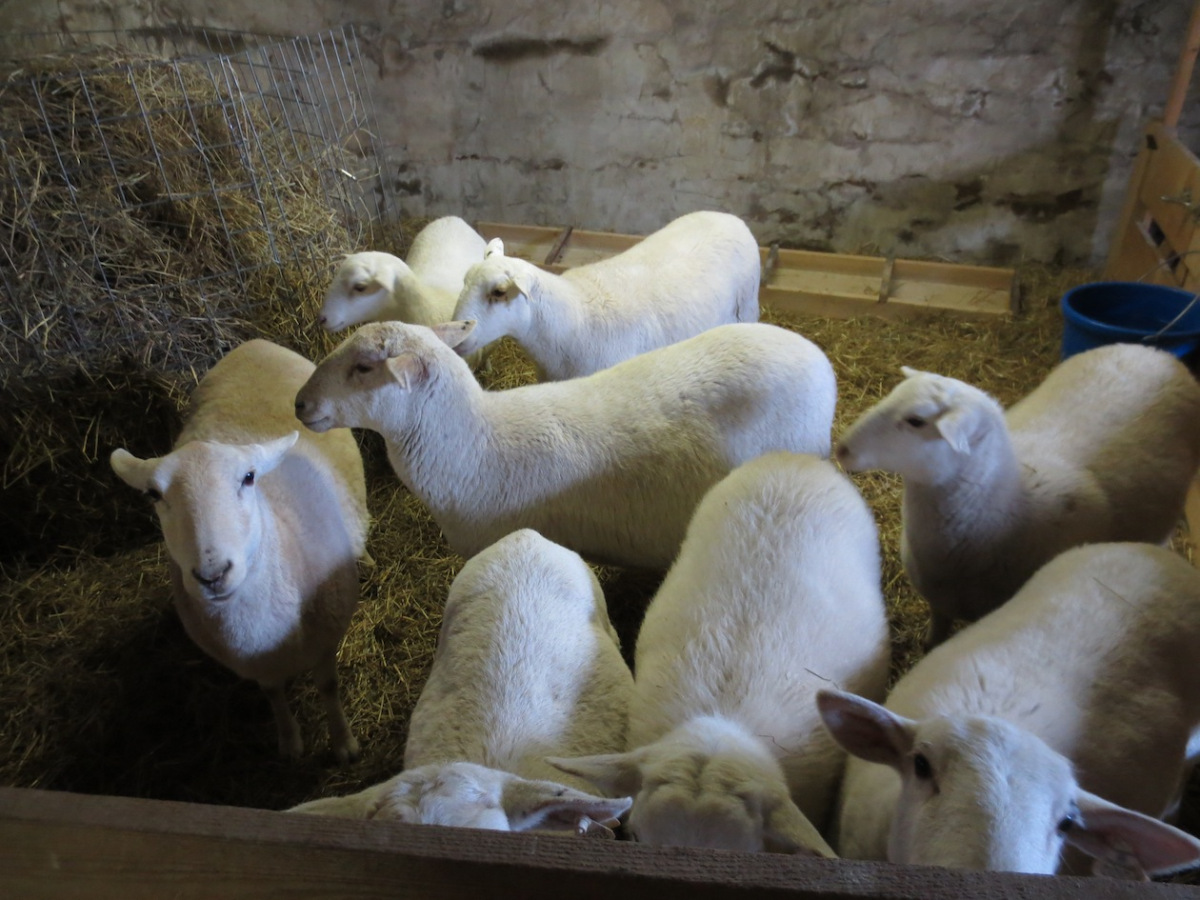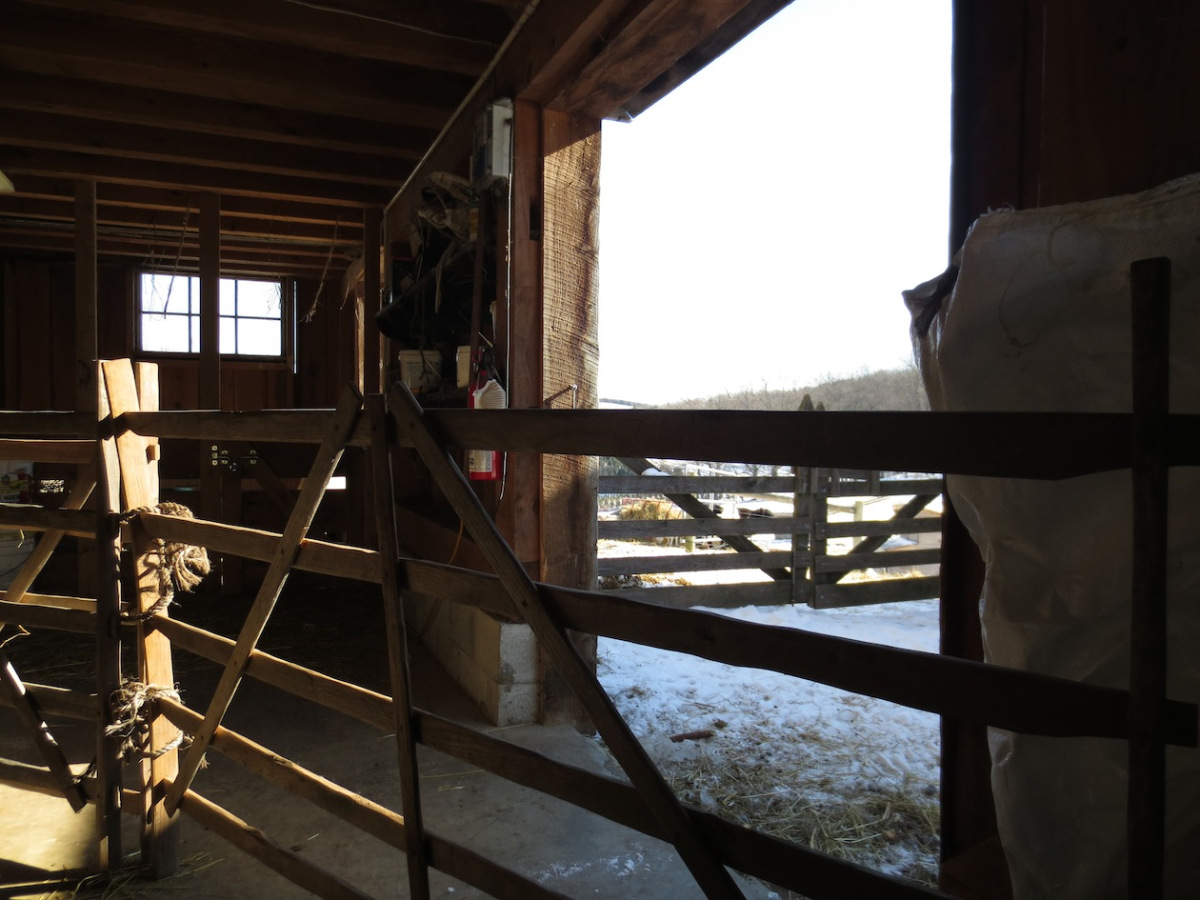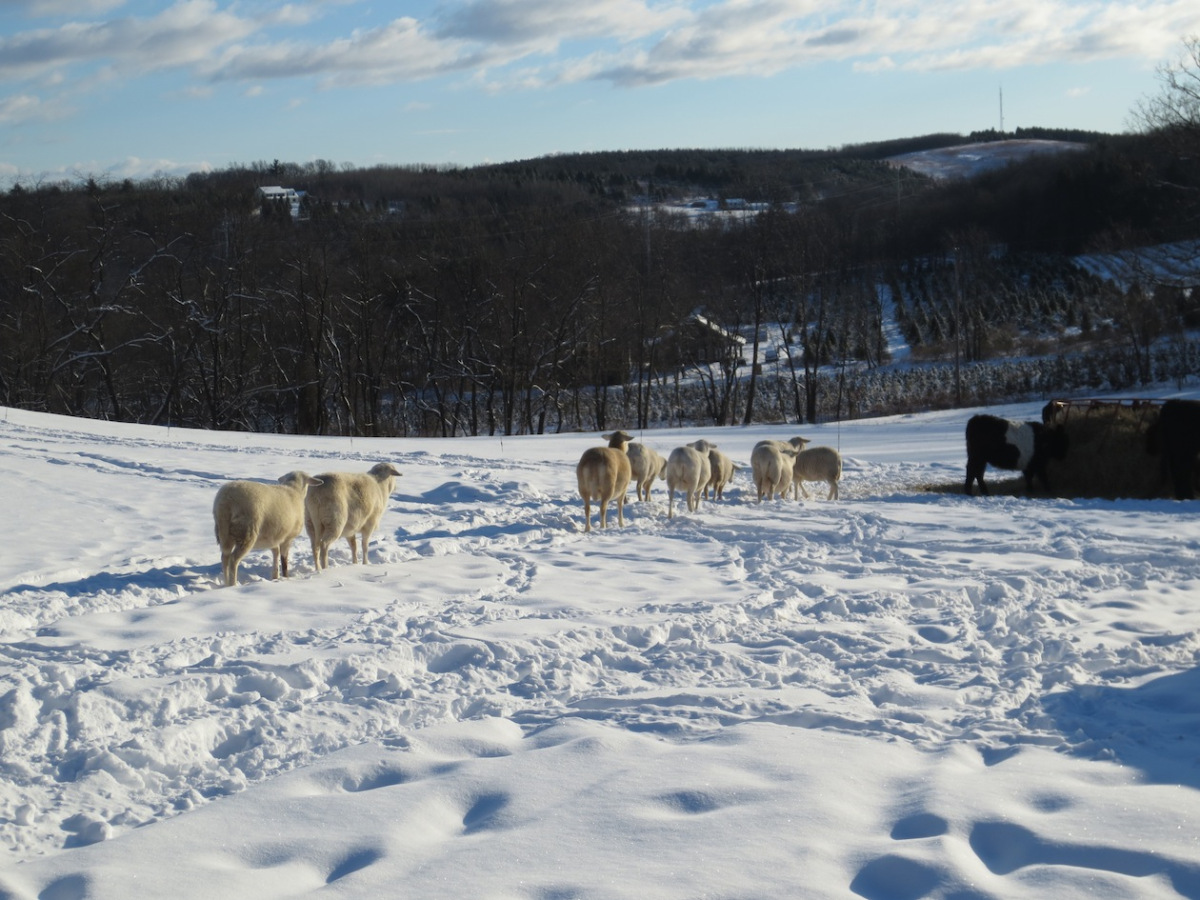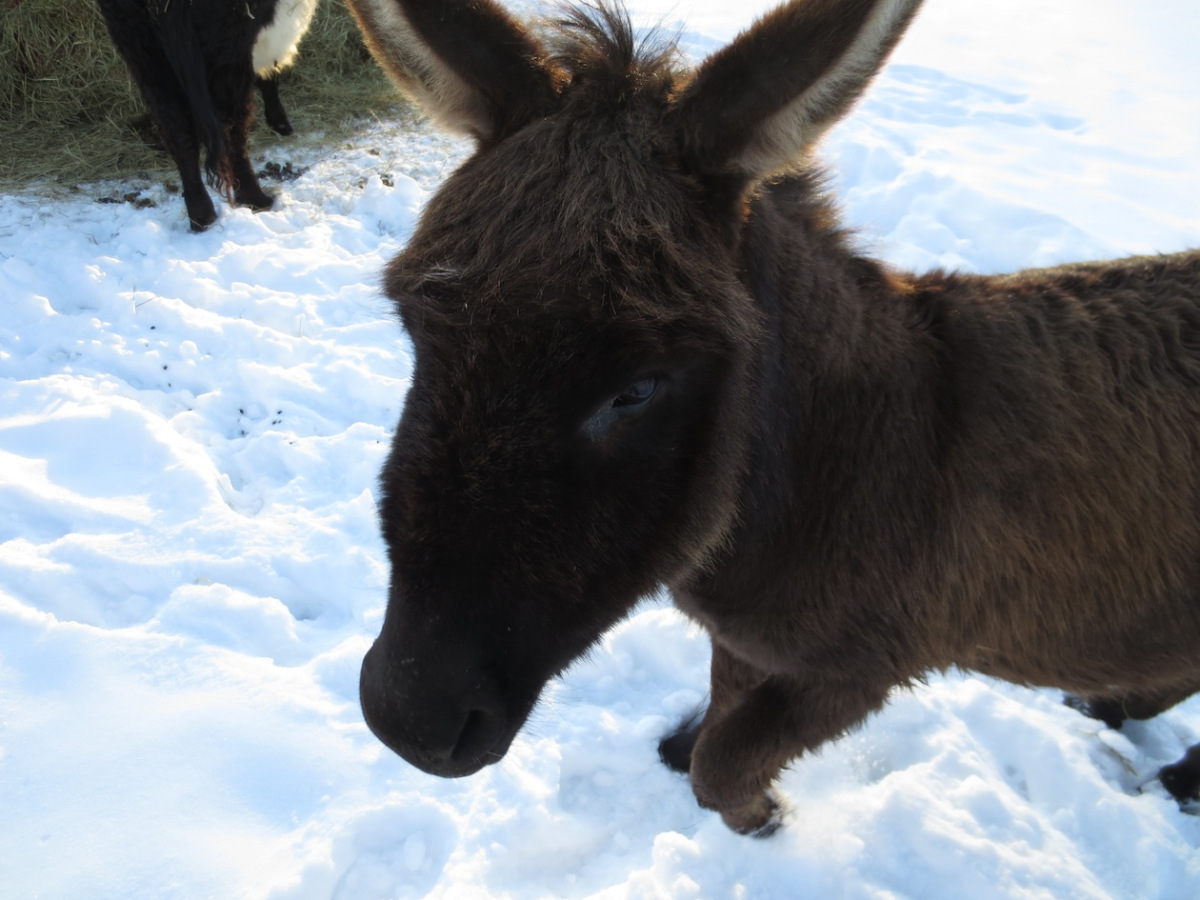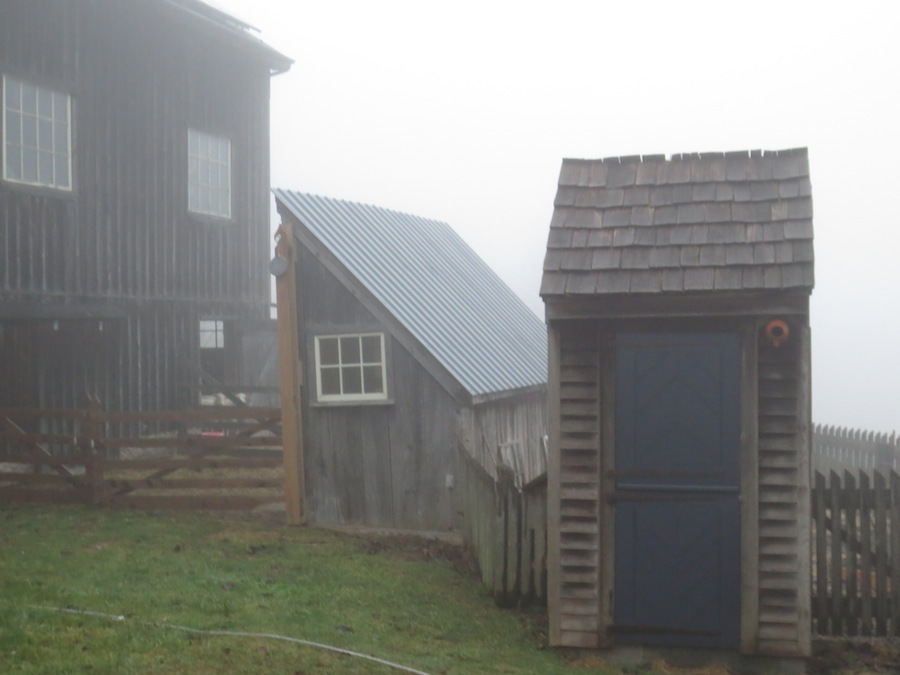Vaccinating, banding and weighing the lambs
Today we vaccinated the lambs with their first Clostridium Perfringens Types C & D-Tetnus Toxoid shots. We will revaccinated in three to four weeks. According to www.sheepandgoat.com:
Enterotoxemia is caused by the bacteria Clostridium perfringins, which is a normal inhabitant of the animal's gut, but can proliferate to toxic levels under certain circumstances. Type C, also called bloody scours or lamb dysentery, usually affects lambs and kids during the first few weeks of life. It is usually precipitated by an increase in feed, such as the start of creep feeding or increased milk availability due to loss of a littermate. Type D, more commonly called overeating disease (and also pulpy kidney disease), affects lambs and kids that are typically over one month of age. Overeating occurs with a sudden change in feed and is associated with high concentrate feeding.
Tetanus, also known as "lockjaw" occurs when the bacteria causing it, Clostridium tetani, gains entry through an open wound or contaminated skin break and proliferates to toxic levels.
The unbanded ram lambs were banded as well.
The two to three week old lambs weighed in at 17 - 25 pounds.
Barn spring
Although the spring equinox occured on March 20 at 7:02 A.M. EDT, snow and cold remained on our bit of land. Lengthening days, nights in the high twenties and day temperatures above freezing have brought a softening to the barnyard this week. With the warmer temperatures the Belties take longer to eat a round bale of hay and the Katahdins can eat their day-ration of hay in the mostly sunny barnyard. Yesterday I rolled up the extension cord and packed away the trough heater when I scrubbed out the Beltie's trough. The heated bucket in the barn was cleaned and stored away until next winter's frigid temps. Dividing the barn pasture with a polytwine fence to limit the heavy hooved cows to a smaller sacrifice paddock will preserve the lower barn pasture.The electrified barrier will also retrain the beef to respect the pulsing fence, a key component of our rotational grazing routine in the growing seasons.The water fowl pens were remulched with the dry hay leavings from around the sheep feeder to keep mislaid eggs and feathers clean.I also reset the temorary posts supporting the fence that keep the four-leggeds separate from the two-leggeds in the barn pasture. Spent corn cobs are effective fencepost wedges,handy after a winter of avian snacking. The miserable kinked hose was retired, hose menders and bronze ends salvaged and a newer hose placed on the rack.
During all these tasks, traipsing back and forth across the yard and pasture I noticed more chores to be tackled. The multiflora rose is reddening and already pushing new growth; my mattock should be brought out of the toolshed for grubbing the tenacious roots. Checking and repairing portable chicken coops is the first step to getting the free ranging , landscape scratching hens out of the yard. Garden cart and wagon tires need to be be retubed and reinflated, orchard trimmings need to be cleared and late spring pruning needs to be completed. Before the sheep are turned out to pasture, I will teach the lambs to avoid the electric fence, trim hooves and worm when necessary.
Even when I get overwhemed by the length of my ever expanding to do list,my routine is never boring.
Managing the early spring pasture
Our Belties spend the winter outside in my sacrifice pasture, with access to run in shelters and close enough to the barn to fill the heated trough. Through the winter I move the location of the round bale feeder to spread out the waste hay and manure. Later in the season this well fenced pasture will be where the lambs learn about electric pulses, where rambunctious animals are pastured when I am away from the farm and where the bull will visit Blair. In an effort to limit the damage casued by heavy hooves and insatiable mouths on spring pasture I set temporary posts in the ground last fall. With warmer temperatures predicted I unrolled the electric twine today closing off the lower section of the barn pasture. Once hay feeding is done and the water fowl pens are moved I will spread out the remaining hay litter and see what comes up.
March 25, 2013
Undeterred by Puxsutawney Phil's predictions for an early spring, snow has been falling all morning. In spite of its inconvenience, I do perfer this light snow to last year's unseasonablely early spring.
With the wethers and ram out of the barn and across the road, I move the ewes and lambs into the barnyard daily. Within the confines of the barn, the lambs learn to move with the flock from the ewes' pen, through the temporary corridor, to the barnyard stall and then the barnyard. The first moves were loud, with ewes calling to their lambs as they made the trip to the outside. After a few days of practice the flock moves as a whole, lambs jostling along as a group and rubbing against their mothers once they reach the barnyard. For our rotational grazing during the green seasons, a flock that moves well together is an asset. This mild, windless day seemd a perfect time to intorduce the lambs to snow.
Boys to the Bachelor Field
With a forkful of hay and a scoop of grain we we able to lead the boys to the field across the road. Moving the boys to the secure field frees up the stall open to the barnyard. Initially the boys had twice daily wheelbarrow hay deliveries. Now they have the round bale feeder from the ewe's pen.They do love to nose around the farthest reaches of the pen.
Two new lambs
Yesterday Mab finally had her lamb. In spite of her girth, a single ram, a 10#at that. She is such an excellant mother I was hoping for a ewe lamb but her ramling is strong and healthy. Mother sheep nuzzle lambs behinds to encourage new lambs to nurse.
This morning a ewe lamb from Owens 13. Like her mother, Beatrice has long legs.On its first day, a new lamb shakily kneels, front feet first, then, tucks in each back leg, then a snooze,
Maude's twin lambs
This morning's peek over the ewe pen gate revealed Maude with pair of white, curly lambs. By the time they were discovered, they were almost dry and full bellied.Portia and Paxton weighed in at 7.5 pounds each. I am especially relieved to see that Maude's lambs are strong and well formed;last year's twins were weak and died early.Mauve and dappled Hugh left the lambing jug to make room for the new family. Hugh's intoduction to the flock was accompanied by Mauve's nickers and protection.
5:30 barn check
No lambs in the barn when I pointed the dim flashlight into the ewes' pen. The short walk back from the barn was peaceful. The morning sky was lightening and the waning cresent moon showed its slightly reddish dark side, Earthshine.
I learned from www.science.nasa.gov:"Leonardo Da Vinci explained the phenomenon nearly 500 years ago. He realized that both Earth and the Moon reflect sunlight. But when the Sun sets anywhere on the Earth-facining side of the Moon (this happens every 29.5 Earth-days) the landscape remains lit -- illuminated by sunlight reflected from our own planet. Astronomers call it Earthshine. It's also known as the Moon's "ashen glow" or "the old Moon in the New Moon's arms."
Reasearchers also note that northern spring is the best time to see the Moon's ashen glow; perfect timing for lambing barn checks.
.
Braised lamb shanks.
Yesterday I poked around the freezer and came up with a couple bags of frozen lamb shanks. Following my Cook's Illustrated, January '95 recipe I browned then braised the shanks in the oven at 350' in a liquid comprised of 3 parts of broth and 2 parts of red wine. The slow cooking in the liquid resulted in tender, non-sinuous, flavorful meat.
First lamb of the season
After a night of dreaming of lambs I found Mauve in the ewe pen with her own spotted ram lamb before dawn. He was already cleaned off and she was nickering to all 8 pounds of him. Mauve is from the first batch of ewes we bought from Dave Hartman. In spite of losing her lamb last year, Mauve knows how to care for her lamb. Mauve is my wildest ewe.Hopefully I can calm her by handling her lamb while they spend time time in the lambing jug.
A winter break
Lilac Hill farm in late winter is all about food, water, shelter and waiting. Waiting for kids and lambs, waiting for nest making and eggs, and waiting for the first bits of green in the pastures. Already the days have lengthened and evening chores are not completed in the dark.
In spite a false alarm when I was away from the farm for 6 days, Gretel waited to kid until the week after my return.On Sunday the 24th Gretel kidded. Ernest (6#) and Cecily (8#) arrived without complications. Unfortunately Gretel's colostrum was too thick for them to nurse so we thinned the milked colustrum and bottle fed it to the Wilde kids (my daughters' name choices were inspired by Ocsar Wilde's "The Importance of Being Ernest") in front of a warming fire. The kids spent the first night in the house then were returned to the barn. All this intervention was guided by our friend, Mike, with years of goat experience and who just happened to come to dinner on Sunday. Gretel came from Mike's farm years ago.
Although we do not see the Wilde kids nurse, they do have milk in their bellies and are very active.
The Katahdin ewes have benefitted from a grain ration at the end of their pregnancies. At the end of January I noticed that the ewes, especialy the yearlings (also know as theaves or gimmers), were losing condition on a hay only diet.Because I needed to put the ram in with the ewes a month early last fall (Burgess' field companion died unexpectedly), the yearlings needed the added nutritional support as they continue to grow while pregnant. Daily, close contact, especially with delicious grain, has gentled the flock and even my shiest Katahdins tolerate closer handling. The older two ewes, Maude and Mab, are obviously getting ready to lamb. It is harder to judge the readiness of the theaves.
A break in the weather
With yesterday's warming (and sleet and rain and mist) running water returned to the barn hydrant.
To avoid sore feet or twisted legs, I will keep the pregant girls, the ewes and Gretel, in the barn. The ram and wethers will stay have access to the barnyard, but not the field with Murphy, the donkey and the Belties. With warming on the way and mud in my future, I will get a round bale out to the cows today.
The new batch of round bales are heavier and mostly Timothy. The larger bales last alot longer limiting skid steer traffic and during the coldest temperatures and the last weeks of pregnancies,when nutritional needs are high, my animals benefit.
Arctic Blast
The last week has found us in the clutches of bitter temperatures. When the temperatures dip into the single digits my barn water hydrant freezes and the frozen waterfowl troughs become too heavy to dump. Fortunately the hydrant in the boat barn is reliable and uphill from the heated field trough so draining the hose after use is easy. Until the duck and goose "ponds" melt a bit, the fowl must be content with buckets of water drawn from the cow and donkey trough. I placed the round bale of hay closer to the hill to provide northly protection from the wind.With the Katahdins and Gretel nearing the end of their pregnancies, I have changed my management practices. Gretel's earliest due date is in the middle of February. She overnights in the goat pen to avoid excess jostling and eats her portion of grain without competition. During the day she roams the barnyard for exercise, eats hay from the round bale feeder and lies in the sun. The ewes now overnight in a paddock fashioned at the bottom of the barn with two pen specific gates and two panels from the trailer pen.The ewes have two 8' troughs set up along the back wall of the barn for their portion of grain. With 16' of trough there is plenty of room for all the ewes to eat without competition. A much distressed Burgess now beds down and eats with the wedding wethers. During the coldest nights I keet the sheep and goats closed in the bottom of the barn. I set up the 4 hurdles as a moveable chute for guiding the ewes and goat away from the bins of grain and out to the paddock. In spite of the frigid temperatures I keep the sheltered door open during the day to welcome in the sun.
Becoming a shepherd is a humbling endeavor. It requires that I observe the sheep, looking for clues to conditions I often do not know exist. For example, I noticed that the yearlings' bellies were rounding, but missed that their condition score was dropping until I ran my hand along their bumpy spines. According to the advice of my books I had planned on starting to feed grain during the last week of January but, experience would have told me to start a week or two earlier. As LHF grows, so will our handling facilities. With more secure fenced fields I will be able separate the yearlings for later breeding dates, to avoid stressing their growing bodies with early first lambings. As my flock grows, staggered lambing dates will also allow me to use the pens that I have without overcrowding. My winter reading list reflects my deficiencies as a shepherd. I have been reading about nutrition and the types of hay best suited to the needs of the sheep, hoping that I will know what to look for when looking at a field ready to be cut and a round bale offered for sale. At a workshop sponsored by Fertrell's I paid particular attention to the talk about feeding small grains to rumninants. I have also been reading about lambing and watching youtube videos to refamiliarize myself with lambing-normal and troubled. Hopefuly when faced with an unexpected problem I will be able to manage and add another "thing" I notice as I tend my sheep.
January 11th, A Beautiful Barnyard Morning
The following post is not an effort to call out Murphy, not our donkey, and his fatalistic "Law" but to note my appreciation for a morning spent doing barnyard chores.
On a windless morning with choretime temperatures in the midthirties, I was hatless as I feed and watered the livestock. The long black hose, that reaches all the way to the goose trough, unrolled easily without its usual frozen stiffness. With a few days of temperatures above freezing and nights not far below, the barnyard is neither an unforgiving, frozen tract nor a sucking, muddy mess making the transfer of waste hay stems to slick or muddy spots easy. While moving forkfuls of the fluffy waste I had time to watch the animals, especially the Belties and Murphy as they investigated my work and the vacated sheep pens. Today I released the wedding sheep from the goat yard. I want them to get more exercise and get accustomed to the ram because they will be penned together when the ewes go into the lambing barn. Murphy hopped into the empty goat stall through its small, barnside door and snuffled around in search of stray grain. Each of the Belties took turns watching longingly with ony room for a black curly head through the hatch. While the cattle and donkey nosed around the barnyard the wedding sheep blended easily to the flock clustered around the hay filled round bale feeder.Hopefully without the intereference of the often present Murphy's Law, I will be able to sort the wedding sheep during evening chores and get them back in their pen for their supplement of grain.
Winter Hay Feeding
Once colder nights arrived I stopped carrying forkfuls of hay twice daily and put a round bale into the feeder.The Belties have 24 hour access to the hay. At first, the Belties and Murphy the donkey were very territorial about the hay feeder, pushing and shoving for position.
As the Katahdins trekked to the feeder Murphy would stand guard and a flick of his ear could dissuade the line of sheep from feeding.Now that there are mutiple circles of trampled hay waste dotting the field and the animals have accustomed themselves to eachother, the sheep eat their fill and head back to the barn for a rest.
Guineas
In an effort to control the tick population, Pearl Guineas were brought to Lilac Farm. They did a superb job and we did not need to treat our 4 dogs with tick repellant from May through October last year. The guineas are very wild, roosting in the trees most nights and ranging through the farmyard, fields and at the neighbor's across the road. Most of the growing season they only pecked the canning tomato plants and the corn and pumpkins, away from the main vegetable garden. They successfully raised two large clutches in the summer and after sharing two birds, eleven guineas remained. The first night they sought shelter in the barn, I captured 7 birds for the butcher. Four guineas fled into the dark.The dark purple carcasses were otherworldy. For a quick dish I sauteed the skinless breast cutlets in butter, garlic, lemon and rosemary. In spite of such little farm management we found the flavor of the tender,white meat more tasty than home grown chicken.
Now the guineas roam, usually spending the night in the barn. Next summer I will need to find a way to protect our gardens, keep the ticks and other insects under control and harvest delicious meat from those wild birds.
The wedding sheep have arrived
On Thursday we brought home four Dorset/Suffolk wethered lambs. These boys are lovely, their wooled, muscled bodies and docked tails are the image that used to come to my mind, before I started raising Katahdins. The four boys are in the goat's paddock, with its strong fences and access to a barn pen where their water will stay warm and I can feed them a daily ration of organic grain. We have installed a hay feeder on the outside wall of the barn for an additional feeding station. As of yet, the sheep have not ventured into the barn. In an effort to draw them into the pen, I left the lights on inside and their hay is in a pile just out of a lamb's neck reach.These lambs are intended for our daughter's wedding meal in May. Her wish is to serve the kind of meal shared around our own dinner table with the wedding guests. Although the wedding "table " will be considerably larger and a caterer will be preparing and serving the food, I am honored to raise these lambs for our family and friends that will celebrate with us.
I have been asked, more than once, how I can choose animals that will end up on our table. Is it uncomfortable? weird? Not really, but I am always ambivalent on butchering day. After all, for months, and in the case of our cows, years, I have been observing these animals daily, noting their gait, body shape, place in the flock or herd. Watching our animals is one of my favorite tasks as a farmsteader. I believe that if I choose to eat meat,and I didn't for 27 years, I have an obligation to eat meat that has been ethically raised or game that has been fairly hunted. Choosing how we manage our land and livestock has clarified my definition of "ethically raised". Additionally when I purchase meat or milk I try to choose so that my parameters of ethical management are met.
December flock observations
While doing the morning chores I had time to watch the Katahdins. For Lilac Hill their strong flocking behavior makes them easy to handle, moving as a group around pastures and through gates. While at rest or grazing they do seem to have preferred buddies. Queen Mab, the calmest of our first ewes on the farm, prefers the company of her daughters. She often stands aside to watch the flock. Like Mab, her daughters are calm and friendly.Mauve and Maude, also from our first set of ewes although not has calm as Mab, are barnyard friends. Maude, who adopted Marilla's orphans in the spring, has recently switched her attentions from the orphans to Mauve.
In the farm book Marilla's twins have names but since they are shy,stick together and avoid human contact, I usually think of them as "the twins". Their sire was of questionable quality so any offspring will not enter the our breeding flock and I will be watching their performance this year. Hopefully they will pass on the strengths of the Katahdin breed.Owen's 13 is a calm ewe lamb from nearby Owen's farm and does not have a particular companion.
I found lambing season gentles the ewes. I the few weeks preceding lambing I confine the ewes to the barn and barnyard. The ewes get accustomed to my comings and goings in close quarters as I do the barn chores and nighttime barn checks. After lambing, when a ewe is in the lambing jug with her new lambs, I can give individual attention to the skittish ewes and get acquainted with the lambs.
Managing a mild December
With temperatures rarely dipping into the twenties so far this December and plenty of rain this week, our sacrifice paddock and the barnyard are thick with mud. To keep the Belties from standing in too much muck while they eat, I regularly move the round bale feeder to fresh footing and spread the remaining chaff over the muddy mess. The stems that remain in the sheep and goat feeder is spread in the barnyard and in the duck and goose pens. Adding wood shavings to the sheep stall, waterfowl pens and Buckeye coop sops up some of the moisture too. Following Joel Salatin's advice, I add enough carbonaceous material to the barn area to keep it sweet smelling.
While carrying forkfuls of hay through boot sucking mud my thoughts turn to planning projects for future seasons on Lilac Hill Farm. In an effort to reclaim this sacrifice field and return it to use next winter I am researching the best combination of covercrops and vegetables to feed my livestock, capture the nutrients left on the land and reduce soil compaction. I hope to fence more of the pastures so that the sheep and cows can stay on pasture until deep snow or a frozen layer of ice demands a move into the barnyard and barn pasture. I am also starting to read about a deep bedding system for the weeks that pasturing is not possible. With hay storage moved to the top of the barn, I could probably move the ewes into the bottom of the barn on deep bedding (adding straw to my need-to-buy list). The Belites will need other accomodations too.
Undeterred by the mud that moderate temperatures, precipitation and bovine hooves churn up, mild weather chores are easier. I have another 2 1/2' of water in the cistern and so as long as I drain the hose at night, watering takes less time without hauling hose from the barn. Eggs don't crack, fingers don't numb and unfrozen buckets are easier to wash so far this December.
